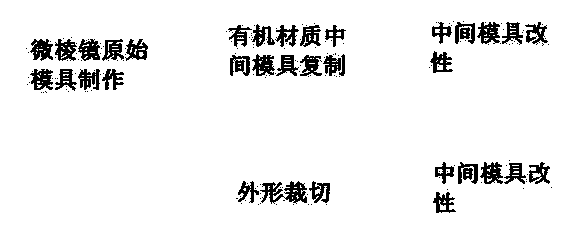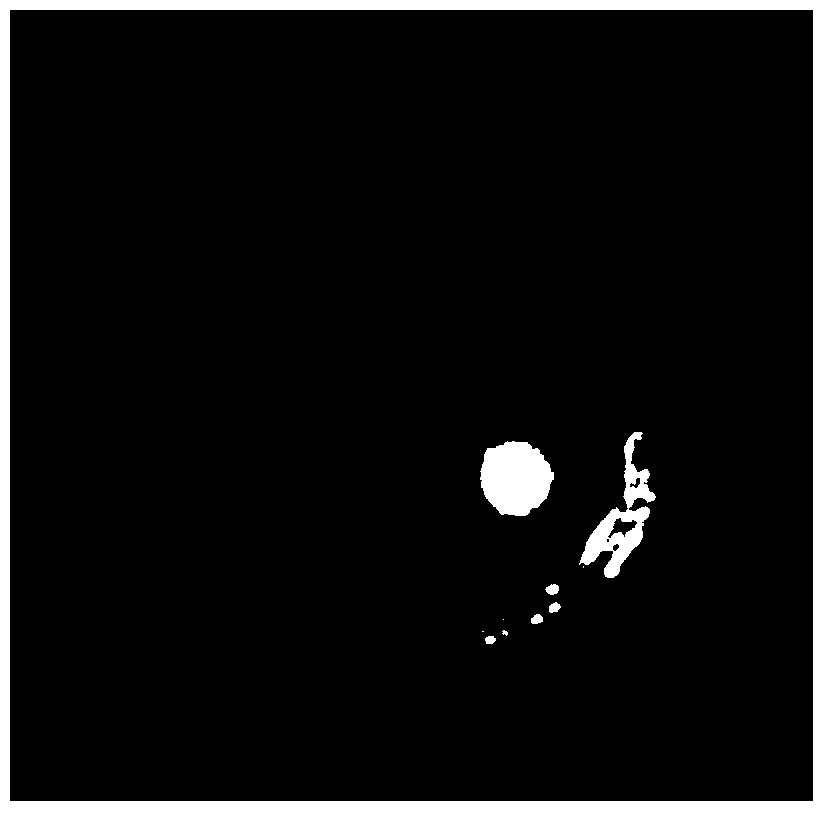Manufacturing method of microprism reflective material
A technology of reflective materials and production methods, applied in optics, optical components, instruments, etc., can solve the problems of large processing tolerance, poor preservation effect, and difficult production, and achieve good cutting and processing performance, which is conducive to preservation and enlargement Effects of retroreflectivity and wide-angle
- Summary
- Abstract
- Description
- Claims
- Application Information
AI Technical Summary
Problems solved by technology
Method used
Image
Examples
Embodiment 1
[0018] Embodiment 1: The original mold of the microprism reflective material is made, and the implementation steps are:
[0019] (1) Use the Y-axis cutting function of the diamond lathe, or the flying knife cutting function to process PMMA, nickel, copper or aluminum micro-prism arrays. The depth of the micro-prism array is 51um, the variable length is 120um, and the Y-axis movement speed is 200mm / min~1000mm / min, Z-axis rough turning feed rate is 5-40um each time, finish turning feed rate is 1-10um each time, the tool is selected with a 70.2-degree included angle tool, and the workpiece is rotated 120 degrees twice around the center of rotational symmetry for turning. Make it intersect to form a triangular pyramid.
[0020] (2) The cutting tool adopts an included angle of 90 degrees, and other process parameters refer to (1), and only cuts once along the Y direction to realize the original mold production of V-groove reflective materials.
[0021] (3) The included angle of t...
Embodiment 2
[0023] Embodiment 2: The intermediate working mold of organic high molecular polymer material is made, and the implementation steps are:
[0024] (1) Evaporate a layer of release agent on the surface of the original mold.
[0025] (2) Coating a layer of material solution such as PDMS or PC or PMMA on the surface of the original mold.
[0026] (3) Heating and curing at 60°C to 150°C for 10 to 100 minutes to achieve sufficient curing of the organic polymer material.
[0027] (4) Using a mechanical stripping method to separate the organic polymer structure pattern from the demoulding of the original mold.
[0028] (5) The separated organic polymer intermediate mold can be used to directly copy the subsequent microprism reflective film, or the intermediate mold can be cut and spliced into a large-area mold according to a certain method for the next step of microprism reflective film replication make.
Embodiment 3
[0029] Embodiment three: Microprism reflective film duplication is made, and implementation steps are:
[0030] (1) Evaporate a layer of fluorine-containing release agent on the surface of the intermediate working mold.
[0031] (2) Apply a layer of photosensitive adhesive on the surface of the intermediate working mold, and cure it under the irradiation of a mercury lamp or an ultraviolet LED lamp. The curing time depends on the thickness of the photosensitive adhesive coating, and the irradiation is sufficient for photosensitive measurement.
[0032] (3) Working in the middle, the surface of the mold is coated with a layer of heat-curing high molecular polymer, and heated with nickel in the temperature range of 60-120 degrees for 10-100 minutes in an oven or infrared heating.
[0033] (4) The release and separation of the microprism reflective material film from the mold is realized by mechanical stripping.
PUM
| Property | Measurement | Unit |
|---|---|---|
| refractive index | aaaaa | aaaaa |
Abstract
Description
Claims
Application Information
 Login to View More
Login to View More - R&D
- Intellectual Property
- Life Sciences
- Materials
- Tech Scout
- Unparalleled Data Quality
- Higher Quality Content
- 60% Fewer Hallucinations
Browse by: Latest US Patents, China's latest patents, Technical Efficacy Thesaurus, Application Domain, Technology Topic, Popular Technical Reports.
© 2025 PatSnap. All rights reserved.Legal|Privacy policy|Modern Slavery Act Transparency Statement|Sitemap|About US| Contact US: help@patsnap.com



